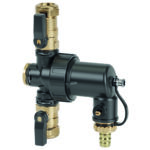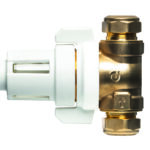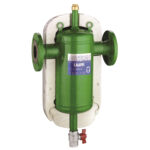All Installers Need to Know About Dirt & Air Separation
Dirt and air in hydronic systems cause operational problems and their removal is a key factor in achieving maximum efficiency.
Steve Elsmore, Senior Technical Support at Altecnic, breaks down why the removal of air from systems is important and describes the components that can be installed to remove air from systems.
What is deaeration?
Deaeration is the process of separating air from water and then eliminating the air from a water distribution system.
Why is air present in the water?
Cold mains water used to fill systems is often more than 95% saturated with dissolved air consisting of a mixture of Oxygen-O2 (21%) and Nitrogen – N2 (78%) and other trace gases which can exist in a dissolved state integral with the water molecules. With non-dissolved air, the gases are separate from the water molecules and are entrained in the form of bubbles of various sizes down to the microscopic level.
The ability of water to retain air is proportional to pressure (according to Henry’s Law) and inversely proportional to temperature. When the temperature or pressure of water is changed such that the solubility is reduced, dissolved air will be released from the water in the form of bubbles.
There are three forms of entrapped air:
• Stationary air pockets at high points
• Entrained micro-bubbles
• Dissolved within water
What problems arise from air in water?
If neglected, the presence of air can lead to many unexpected consequences; premature deterioration of equipment and decrease in overall system efficiency. Free gas bubbles may significantly affect the circulation. As bubbles pass along a water distribution system, they can coalesce (bind together) in areas of low velocity to create localised air pockets which remain in place and reduce flow rate.
Oxygen is a highly reactive gas and if air is constantly present in a system because of inadequate deaeration, continuous exposure would accelerate corrosion of ferrous materials, affecting steel piping, cast iron boilers, expansion tanks, eventually leading to reduced performance and leaks.
Which products are used for deaeration?
Automatic Air Vents will provide system venting during initial filling of the system (and draining where necessary). Air vents are not intended for operational venting when directly installed on flowing pipes. They are designed such that accumulated gases are vented off but they are not able to separate bubbles from flowing water. The design of separators causes the flow velocity to be locally reduced within the main body allowing existing bubbles in the less turbulent water to rise to the top and the gases are expelled through an integral, top mounted Automatic Air Vent.
Separators for micro-bubbles are compact units and are suitable for operational de-gassing and continuous venting. An internal mesh type of baffle with sharp edges induces the micro-bubbles to cling to the surface which then coalesce into larger bubbles which rise and are expelled to atmosphere.
Manual Air Vents are often sufficient to eliminate air pockets in heat emitters such as radiators.
What is dirt separation?
Dirt separation refers to the process of removing solid particles, debris, and contaminants from a water system. In the context of heating and cooling systems, dirt separation is crucial to prevent clogs and maintain system performance.
What problems arise from dirt in water?
The presence of dirt and debris can reduce the efficiency of water systems. In heating and cooling systems, dirt can accumulate on heat exchangers and pipes, insulating them and reducing their ability to transfer heat effectively. This results in higher energy consumption and reduced performance.
Dirt particles can accumulate in pipes, valves, and filters, leading to clogs and blockages. This can restrict water flow, decrease water pressure, and cause damage to equipment over time. Furthermore, particles in the water can act as abrasives, accelerating the wear and tear on pipes and equipment. This can lead to corrosion, leaks, and the need for costly repairs or replacements.
Depending on the nature of the dirt or contaminants, they can introduce impurities into the water, potentially making it unsafe for consumption or industrial processes. Microorganisms and organic matter can also promote the growth of harmful bacteria.
What products are used for dirt separation?
The installation of a dirt separator is essential for maintaining the cleanliness and efficiency of water systems. Strainers and filters are the most commonly used dirt separation products in water systems. These use a mesh or screen to physically filter out larger particles and debris from the water.
Building on this, magnetic separators are also used in residential and commercial plumbing and heating systems. These use magnets to attract magnetic particles in the water.
To tackle both issues of air and dirt in water, dirt and air separators can be installed. These remove both air bubbles and dirt particles from the water, improving system efficiency.
Finding a solution
The DIRTMAG MINI™ dirt separator and strainer separates impurities from air conditioning systems to protect the boiler circulator and heat exchanger. The removable magnet captures the ferromagnetic particles, whilst the mesh strainer and dirt separator capture the remaining debris.

For installations with limited space, the new CALEFFI XS® under boiler magnetic filter is designed to protect heating and cooling systems from the harmful effects of impurities. The mesh filter captures large particles, such as dirt and sand, while the magnet attracts and traps metal particles. The collection chamber captures the heaviest particles, such as rust and scale.

For commercial solutions, the Altecnic DISCALDIRT® 546 Series deaerator-dirt separator, available in sizes DN50 – DN 150, utilises the combined action of several physics principles to solve the problem. The active part consists of a set of concentric metal mesh surfaces. These elements create the swirling motion required to facilitate the release of micro-bubbles and their adhesion to the surfaces. The bubbles, fusing with each other, increase in volume until the hydrostatic thrust is sufficient to overcome the force of adhesion to the structure. They then rise towards the top of the device and are expelled through a float - operated automatic air vent valve. The impurities in the water, colliding with the metal surfaces of which the internal element is composed, are separated out and fall to the bottom of the valve body.

